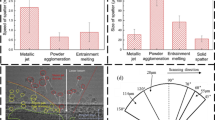Abstract
The effect of anhydrous lactose particle size distribution on its performance in the wet granulation process was evaluated. Three grades of anhydrous lactose were used in the study: “as is” manufacturer grade and 2 particle size fractions obtained by screening of the 60M lactose. Particle growth behavior of the 3 lactose grades was evaluated in a high shear mixer. Compactibility and porosity of the resulting granules were also evaluated. A uniaxial compression test on moist agglomerates of the 3 lactose grades was performed in an attempt to explain the mechanism of particle size effect observed in the high shear mixer. Particle growth of anhydrous lactose in the high shear mixer was inversely related to the particle size of the starting material. In addition, granulation manufactured using the grade with the smallest particle size was more porous and demonstrated enhanced compactibility compared with the other grades. Compacts with similar porosity and low liquid saturation demonstrated brittle behavior and their breakage strength was inversely related to lactose particle size in the uniaxial compression test, suggesting that material with smaller particle size may exhibit more pronounced nucleation behavior during wet granulation. On the other hand, compacts prepared at higher liquid saturation and similar compression force exhibited more plastic behavior and showed lower yield stress for the grade with smallest particle size. The lower yield stress of compacts prepared with this grade may indicate a higher coalescence tendency for its granules during wet granulation.
Similar content being viewed by others
References
Kristensen HG. Agglomeration of powders.Acta Pharm Suec. 1988;25:187–204.
Tardos IG, Khan MI, Mort PR. Critical parameters and limiting conditions in binder granulation of fine powders.Powder Technol. 1997;94:245–258.
Ouchiyama N, Tanaka T. The probability of coalescence in granulation kinetics.Ind Eng Chem Process Des Dev. 1975;14:286–289.
Iveson SM, Beathe JA, Page NW. The dynamic strength of partially saturated powder compacts: the effect of liquid properties.Powder Technol. 2002;127:149–161.
Liu LX, Lister JD, Iveson SM, Ennis BJ. Coalescence of deformable granules in wet granulation processes.AIChE J. 2000;46:529–539.
Iveson SM, Lister JD, Hapgood H K, Ennis BJ. Nucleation, growth and breakage phenomenon in agitated wet granulation process: a review.Powder Technol. 2001;117:3–39.
Holm P, Schaefer T, Kristensen HG. Granulation in high-speed mixers. Part V. Power consumption and temperature changes during granulation.Powder Technol. 1985;43:213–223.
Kristensen HG, Holm P, Schaefer T. Mechanical properties of moist agglomerates in relation to granulation mechanisms. Part I. Deformability of moist, densified agglomerates.Powder Technol. 1985;44:227–237.
Kristensen HG, Holm P, Schaefer T. Mechanical properties of moist agglomerates in relation to granulation mechanisms. Part II. Effect of particle size distribution.Powder Technol. 1985;44:239–247.
Badawy SIF, Lee TJ, Menning MM. Effect of drug substance particle size on the characteristics of granulation manufactured in a high shear mixer.AAPS PharmSciTech. 2000;1(4):E33.
Badawy SIF, Menning MM, Gorko MA, Gilbert DL. Effect of process parameters on compressibility of granulation manufactured in a high shear mixer.Int J Pharm. 2000;198:51–56.
Wikberg M, Alderborn G. Compression characteristics of granulated materials. IV. The effect of granule porosity on the fragmentation propensity and compactibility of some granulations.Int J Pharm. 1991;69:239–253.
Kibbe AH. Lactose. In:Handbook of Pharmaceutical Excipients. Washington, DC: American Pharmaceutical Association; 2000: 278.
Author information
Authors and Affiliations
Corresponding author
Rights and permissions
About this article
Cite this article
Badawy, S.I.F., Hussain, M.A. Effect of starting material particle size on its agglomeration behavior in high shear wet granulation. AAPS PharmSciTech 5, 38 (2004). https://doi.org/10.1208/pt050338
Received:
Accepted:
DOI: https://doi.org/10.1208/pt050338




